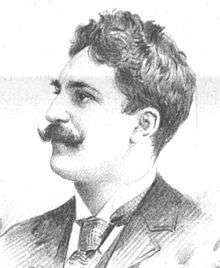Siegmund Eibenschütz
Siegmund Eibenschütz (19 November 1856 – 19 February 1922) was an Austrian theatre director and conductor.

Life
Born in Budapest Austrian Empire, Eibenschütz studied at the Franz Liszt Academy of Music with Franz Liszt, Robert Volkmann and Ferenc Erkel. Together with his sister Ilona, who was an important piano virtuoso, he undertook concert tours throughout Europe. Finally he settled in Vienna and became an opera répétiteur in the school of Luise Meyer-Dustmann with Pauline Lucca.[1]
Since 1887 he conducted at all major theaters in Austria and in 1895 he joined the Theater an der Wien for 10 years. His wife was the famous soubrette Dora Keplinger. In 1907 he became partner of Andreas Amann, the director of the Carltheater, which he finally directed from 1908 till his death. Under his direction only operettas were performed at the Carltheater and of 19 works there were only 6 which were performed less than 100 times in a row. Among the better known works were Franz Lehár's Gipsy Love and Oskar Nedbal's Polenblut (see Polish Blood).
Eibenschütz died in Vienna at the age of 55 and was buried at the Lutheran Cemetery Vienna-Simmering (VIII, Av. 29)
His sisters were the pianist Ilona Eibenschütz, the opera singer Riza Eibenschütz and the actress Gina Eibenschütz, his daughter the singing teacher Maria Theodora Eibenschütz.[2]
Further reading
- Eibenschütz Siegmund on OELM
- Elisabeth Th. Hilscher-Fritz, Monika Kornberger: Eibenschuetz, Familie. In: Oesterreichisches Musiklexikon. Online-edition, Vienna 2002 ff., ISBN 3-7001-3077-5; Print edition: Volume 1, published by the Austrian Academy of Sciences, Vienna 2002, ISBN 3-7001-3043-0.
- Franz Hadamowsky: Wien Theatergeschichte. Vienna 1994, p. 609ff.
- Hans Havelka: Der Wiener Zentralfriedhof.[3] Vienna 1989, p. 131.
- Walter Kleindel: Das große Buch der Österreicher. Vienna 1987, p. 88.
- Felix Czeike: Historisches Lexikon Wien, volume 2. Kremayr & Scheriau, Vienna 1997, p. 139, ISBN 3-218-00547-7.
References
- Eibenschütz, Siegmund on OBL
- Eibenschütz, Siegmund on VIAF
- Der Wiener Zentralfriedhof on WorldCat